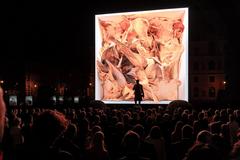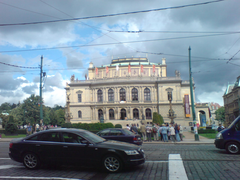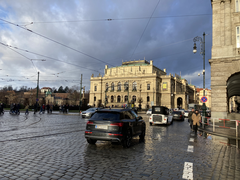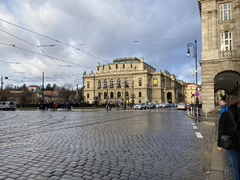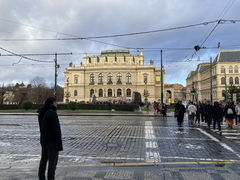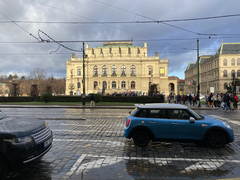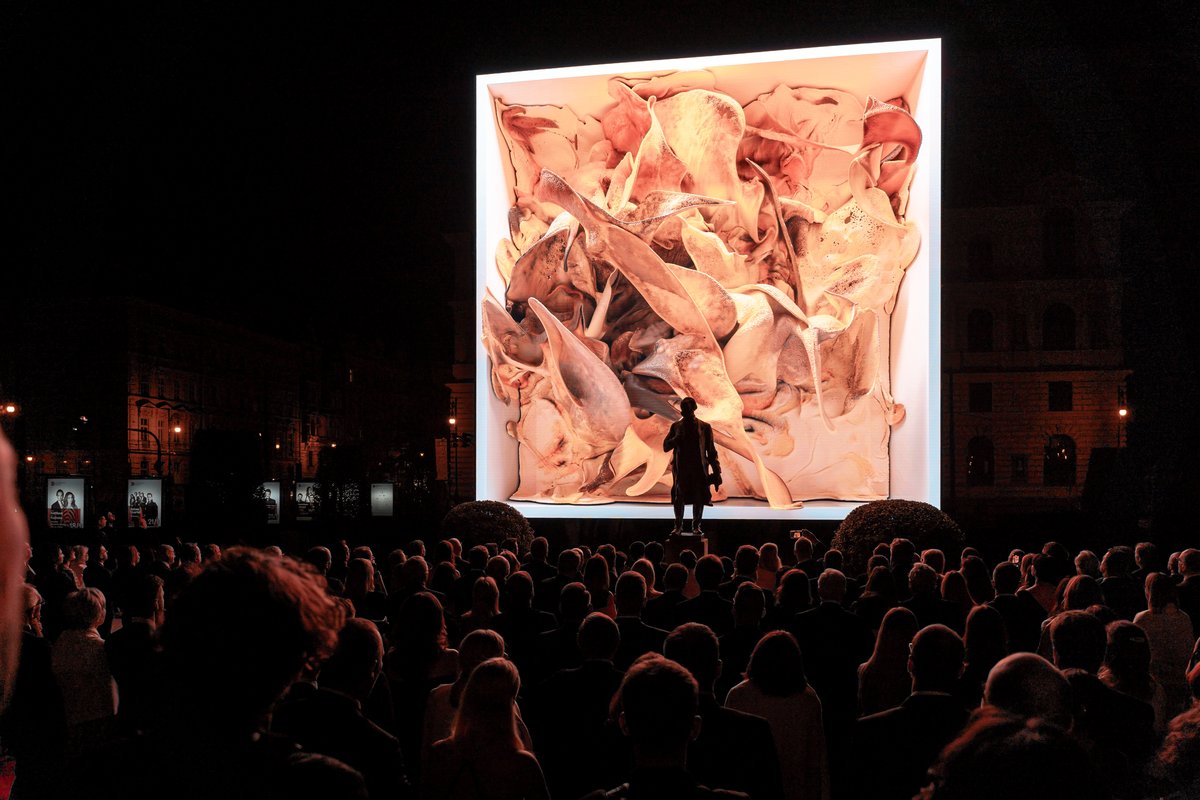
Rudolfinum Prague: Visiting Hours, Tickets, and Historical Significance
Date: 14/06/2025
Introduction
The Rudolfinum in Prague stands as a beacon of Czech culture, uniting history, music, and architectural brilliance. Located on Jan Palach Square beside the Vltava River, this Neo-Renaissance masterpiece is both a concert hall and an art gallery. Since its inauguration in 1885, the Rudolfinum has played a pivotal role in the artistic and national identity of the Czech Republic, hosting the esteemed Czech Philharmonic Orchestra and the Galerie Rudolfinum, a premier venue for contemporary art. This guide presents a comprehensive overview of the Rudolfinum’s history, architectural highlights, visitor information, and practical tips to ensure a rewarding experience for every guest.
Historical Overview
Origins and Construction
The Rudolfinum’s origins date back to the late 19th century, a period of cultural awakening for the Czech people within the Austro-Hungarian Empire. Commissioned by Česká spořitelna (the Czech Savings Bank) to mark its 50th anniversary, the building was designed by celebrated Czech architects Josef Zítek and Josef Schulz. Construction took place from 1876 to 1884. The Rudolfinum was named after Crown Prince Rudolf of Austria and officially opened on February 7, 1885 (yourcityvisit.com, praguehere.com, rudolfinum.cz). Its strategic location on the Vltava’s right bank positioned it as a focal point of Prague’s cultural and intellectual life.
Architectural Significance
An exemplary Neo-Renaissance structure, the Rudolfinum boasts a symmetrical façade, classical columns, ornate sculptures, and decorative reliefs. Sculptures of composers such as Beethoven, Bach, and Mozart line the rooftop, symbolizing the building’s dedication to music. The ceremonial staircase and 25 arches along the west front create a grand entrance, while translucent ceilings and large windows fill the interiors with natural light, enhancing both art displays and musical performances (pragueclassicalconcerts.com, visitprague.info, rudolfinum.cz).
Evolution Through Czech History
- World War I: Repurposed as a military hospital, putting cultural activities on hold (colosseumticket.cz).
- First Czechoslovak Republic (1918–1939): Served as the seat of the Chamber of Deputies, playing a central role in the new nation’s political life (galerierudolfinum.cz).
- World War II: Used for German Philharmonic concerts, yet preserved architecturally (galerierudolfinum.cz).
- Postwar and Communist Era: In 1946, the Rudolfinum became the home of the Czech Philharmonic Orchestra and the Prague Spring International Music Festival. The building was modernized and restored in the late 20th century, ensuring its continued status as a cultural landmark (yourcityvisit.com, colosseumticket.cz).
Architectural and Artistic Highlights
Dvořák Hall
The heart of the Rudolfinum is Dvořák Hall, renowned worldwide for its outstanding acoustics and lavish Neo-Renaissance décor. With a seating capacity of around 1,100, the hall hosted the Czech Philharmonic’s inaugural concert in 1896 under the baton of Antonín Dvořák (pragueviews.com, visitprague.info). It remains the main venue for the orchestra’s regular season and international festivals.
Other Halls and Spaces
- Suk Hall: An intimate venue for chamber music, private events, and screenings (timeout.com).
- Kubelík Hall: Opened in 1994 and named for violinist Jan Kubelík, this space combines exhibition areas with elegant architectural features (praguetouristinformation.com).
- Galerie Rudolfinum: A contemporary art gallery focusing on temporary exhibitions, without a permanent collection. The gallery’s innovative programming makes it a leader in Prague’s art scene (galerierudolfinum.cz, visitprague.info).
Café Rudolfinum and Amenities
The Café Rudolfinum, located on the lower level, offers specialty coffee, fine wines, and honey from rooftop beehives (pragueviews.com). A shop nearby features souvenirs and unique Rudolfinum creations (timeout.com). Restrooms, cloakrooms, and accessibility features are available for all visitors.
Cultural Impact and Significance
The Rudolfinum is not merely a concert hall or gallery—it is a living symbol of Czech resilience and creativity. From its early days, debates around its programming and use reflected broader questions of national identity. It has witnessed key events in Czech history, such as the election of Tomáš Garrigue Masaryk as president and the persistence of Czech culture during occupation (rudolfinum.cz, ceskafilharmonie.cz).
Home to the Czech Philharmonic since 1946, the Rudolfinum is recognized globally for its role in nurturing the country’s greatest composers and musicians. The Dvořák Hall’s acoustics attract world-class performers, while the Galerie Rudolfinum’s exhibitions foster contemporary artistic innovation (pragueexperience.com, galerierudolfinum.cz).
The Rudolfinum’s commitment to educational and community engagement is visible through its wide array of programs for young audiences and its integration into citywide cultural events (rudolfinum.cz).
Practical Visitor Information
Visiting Hours
- Galerie Rudolfinum: Tuesday to Sunday, 10:00 AM – 6:00 PM (extended to 8:00 PM on Thursdays), closed Mondays and during exhibition installations (rudolfinum.cz).
- Café Rudolfinum: Tuesday to Sunday, 9:00 AM – 10:00 PM; closed Mondays (praguehere.com).
- Concerts: Event-specific; check the official Czech Philharmonic or Rudolfinum website for schedules.
Tickets
- Concerts: Purchase tickets online via Czech Philharmonic, Rudolfinum event program, or at the box office. Advance booking is highly recommended, especially for popular events.
- Galerie Rudolfinum: Admission is generally free except for special exhibitions (galerierudolfinum.cz).
- Discounts: Reduced prices for children, seniors, students, and holders of ZTP cards. Last-minute student tickets and gift vouchers are available (Czech Philharmonic).
Accessibility
- The Rudolfinum is fully wheelchair accessible, with ramps and elevators. A dedicated barrier-free entrance is on 17. listopadu Street. Assistance can be arranged in advance (Czech Philharmonic).
Transportation
- Address: Alšovo nábřeží 12, Praha 1 – 110 00.
- Metro: Staroměstská station (Line A).
- Tram: Lines 17 and 18 to ‘Staroměstská’ or ‘Alšovo nábřeží’.
- Parking: Limited and expensive; public transport is highly recommended (Rudolfinum.cz).
Guided Tours
- Guided tours of the Rudolfinum and its halls are periodically available and should be booked in advance through the official website for insights into architecture, history, and art (rudolfinum.cz).
Amenities
- Restrooms, cloakrooms, and souvenir shops are available.
- Café Rudolfinum offers light refreshments; many restaurants and cafés are nearby.
- Photography is permitted in public and gallery areas but not during concerts or some exhibitions.
Notable Nearby Attractions
- Charles Bridge
- Old Town Square and Astronomical Clock
- Museum of Decorative Arts
- Kampa Island and Vltava river walks (Lonely Planet)
Key Historical Milestones
- 1876–1884: Construction by Josef Zítek and Josef Schulz.
- 1885: Inauguration, named for Crown Prince Rudolf.
- 1896: Czech Philharmonic’s inaugural concert under Antonín Dvořák.
- 1914–1918: Used as a military hospital during World War I.
- 1919–1939: Served as the seat of the Czechoslovak Parliament.
- 1946: Czech Philharmonic reinstated; host of Prague Spring Festival.
- 1989–1992: Comprehensive restoration and modernization.
- 1994: Galerie Rudolfinum opens as a contemporary art venue.
Frequently Asked Questions (FAQ)
Q: What are Rudolfinum’s visiting hours?
A: Galerie Rudolfinum is open Tuesday to Sunday, 10:00 AM – 6:00 PM (to 8:00 PM on Thursdays). Concerts occur as scheduled.
Q: How do I buy Rudolfinum tickets?
A: Tickets are available online via official platforms, at the box office, or by phone/email. Advance booking is recommended.
Q: Is the Rudolfinum wheelchair accessible?
A: Yes, with ramps, elevators, and a dedicated entrance.
Q: Are guided tours available?
A: Yes, bookable in advance via the official website.
Q: Is photography allowed?
A: In public and gallery areas, yes; not during concerts or some exhibitions.
Visitor Recommendations and Tips
- Book concert tickets early, especially for the Czech Philharmonic.
- Visit in the morning or late afternoon for a quieter experience.
- Use public transportation to avoid parking hassles.
- Check the official schedule for special exhibitions and events.
- Dress smart casual or semi-formal for concerts.
Plan Your Visit: Additional Resources
- Rudolfinum Official Website
- Czech Philharmonic Tickets
- Galerie Rudolfinum
- GoOut – Rudolfinum Venue Info
- Interactive Map of Prague Historic Center
Conclusion
The Rudolfinum is a cornerstone of Prague’s cultural and artistic life, uniting world-class music, cutting-edge art, and architectural splendor. Whether attending a Czech Philharmonic concert, exploring a contemporary art exhibition, or admiring its Neo-Renaissance grandeur, every visit is an immersion in Czech heritage. Make the most of your experience by planning ahead—check schedules, secure tickets, and discover nearby landmarks. Download the Audiala app for curated tours and updates, and follow the Rudolfinum on social media for the latest news.
Experience the living heart of Czech culture at the Rudolfinum—where music, art, and history converge.
Sources
- yourcityvisit.com
- praguehere.com
- rudolfinum.cz
- ceskafilharmonie.cz
- galerierudolfinum.cz
- visitprague.info
- colosseumticket.cz
- pragueexperience.com
- pragueclassicalconcerts.com
- pragueviews.com
- timeout.com
- praguetouristinformation.com
- avantgarde-prague.com
- pragueopera-tickets.com
- visitczechia.com
- expats.cz
- GoOut
- Real Prague Guides
- The Invisible Tourist
- Lonely Planet
